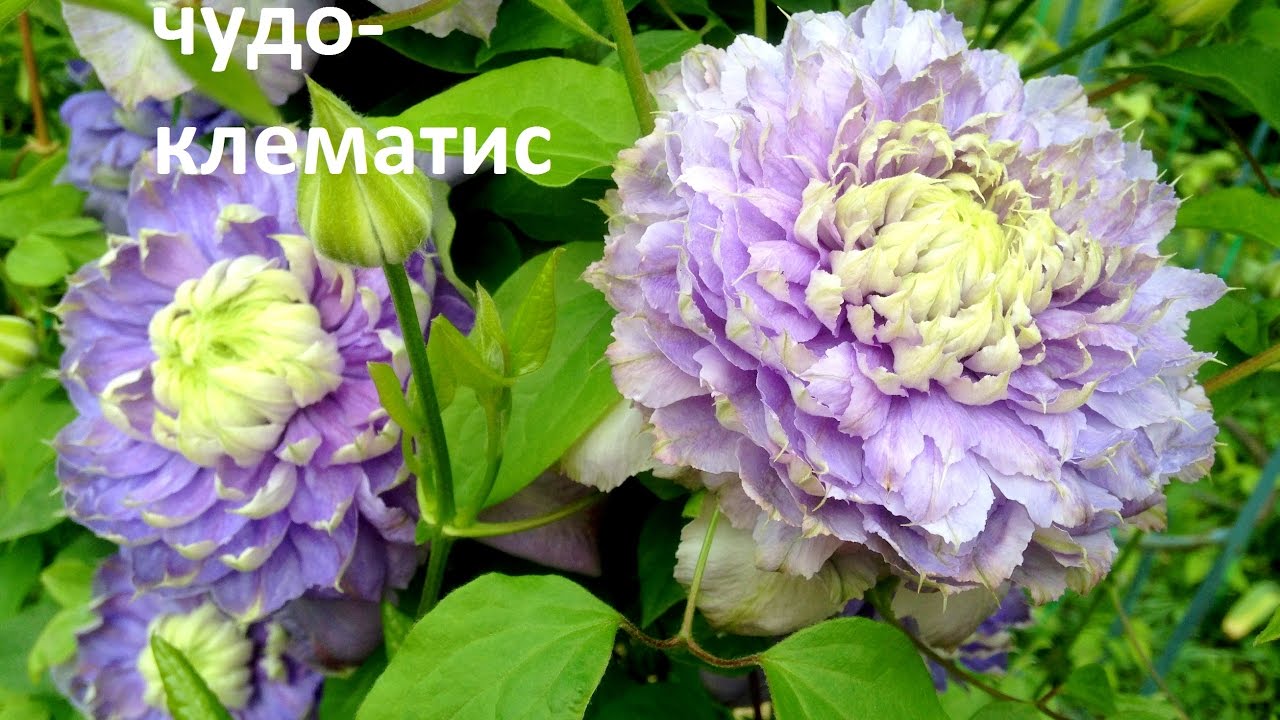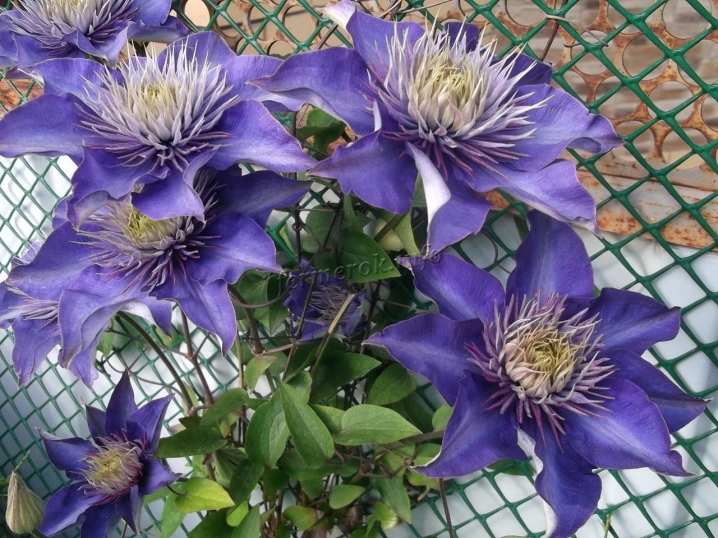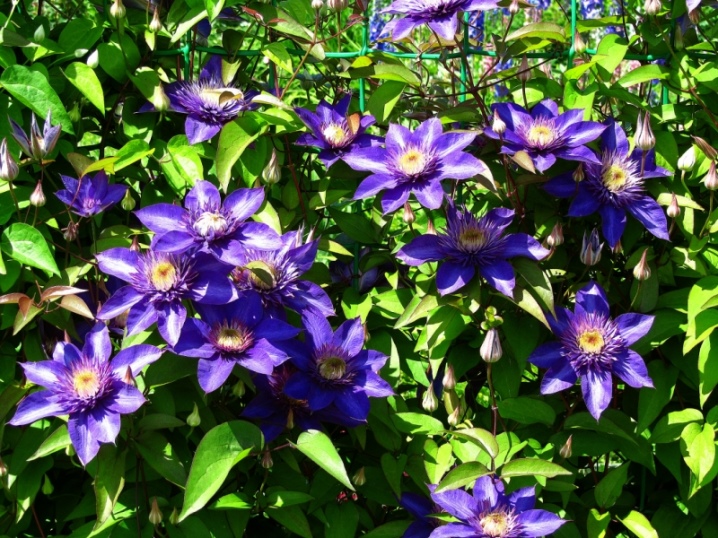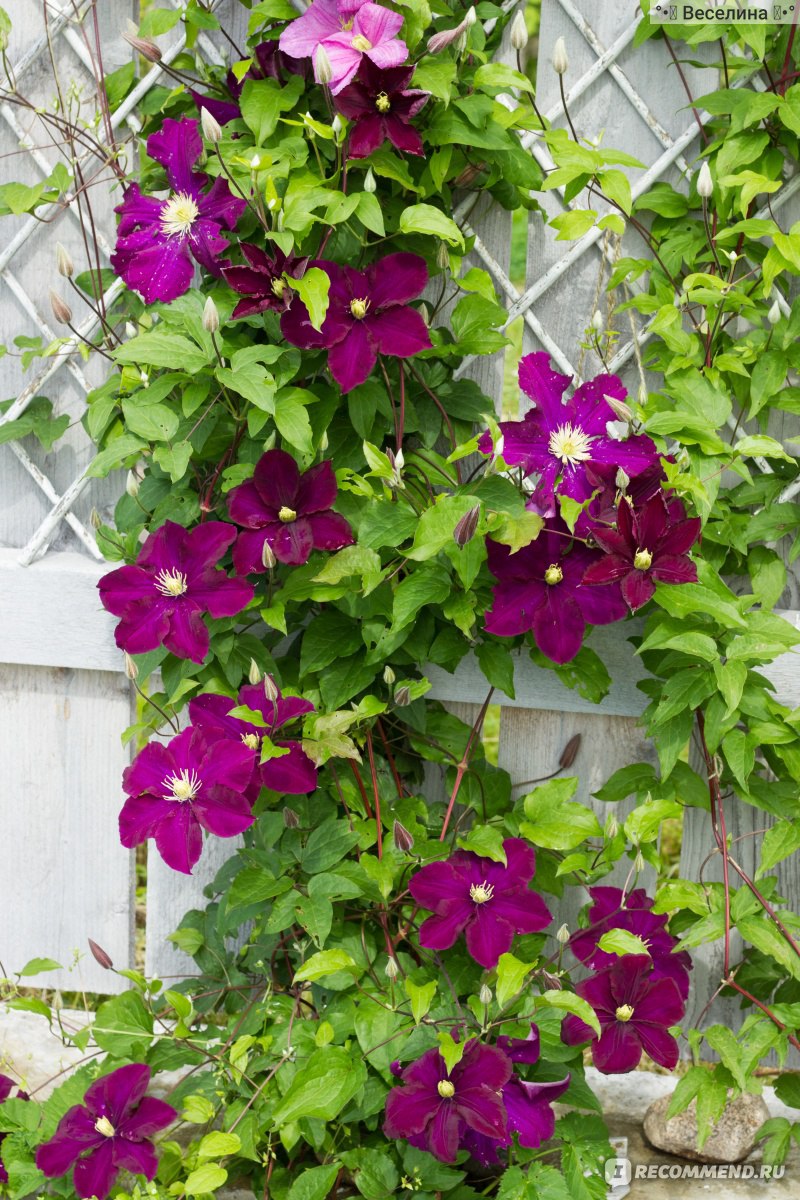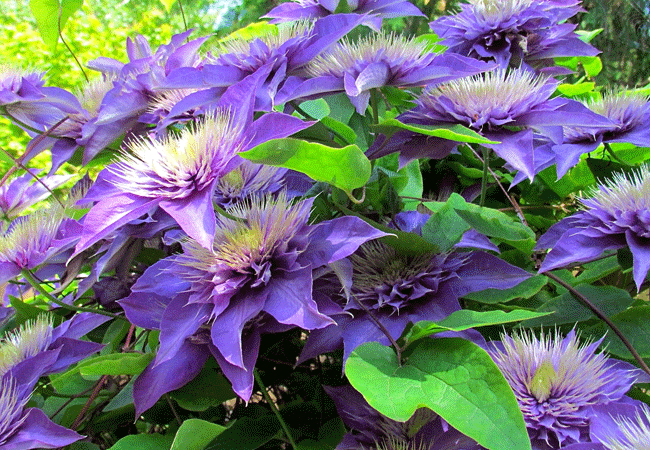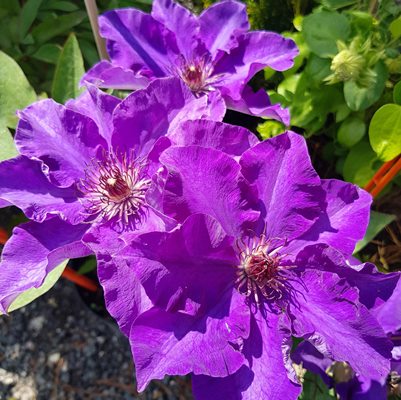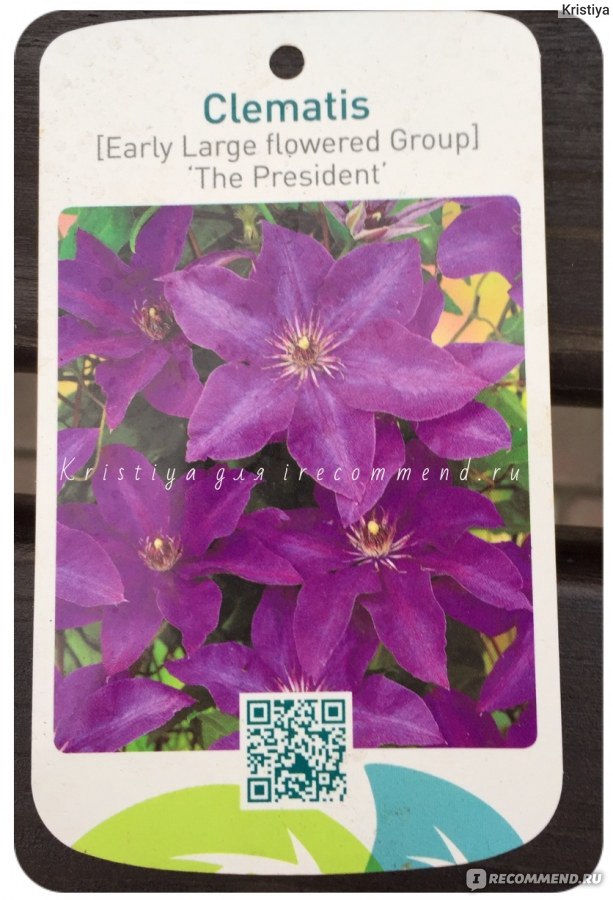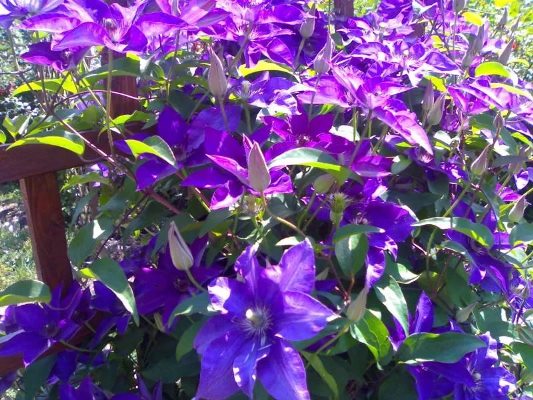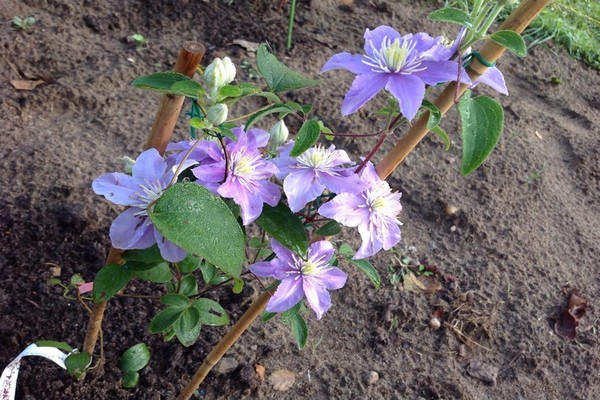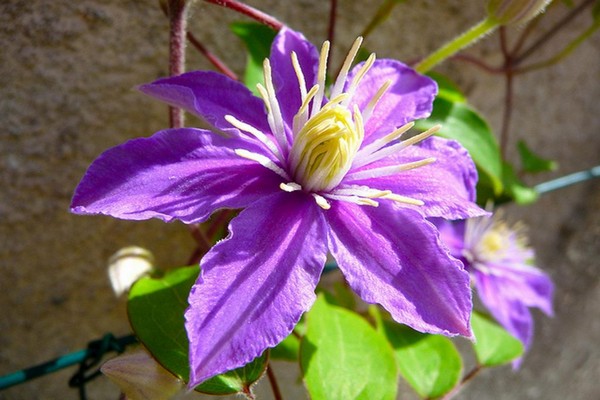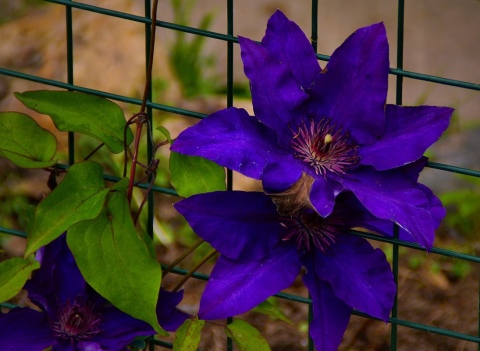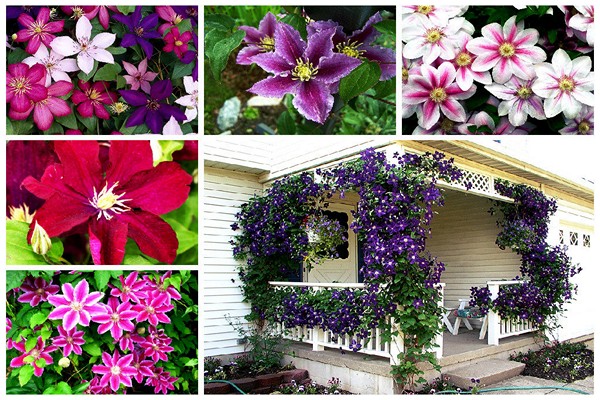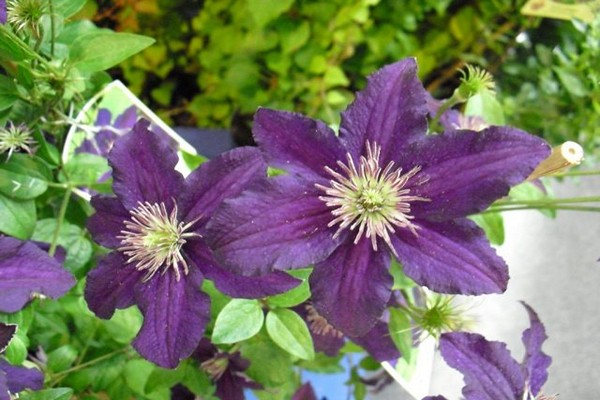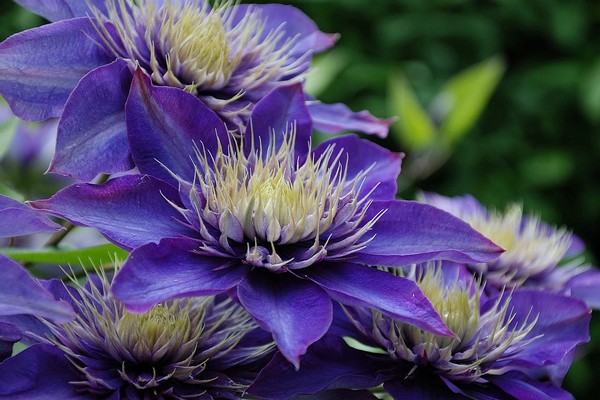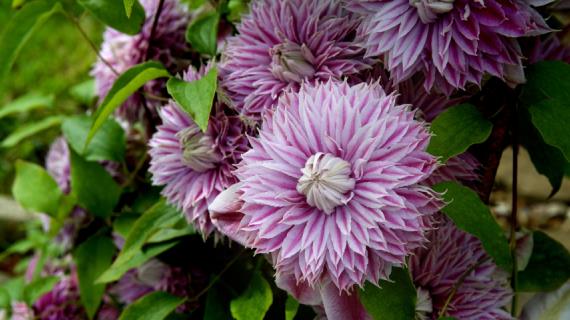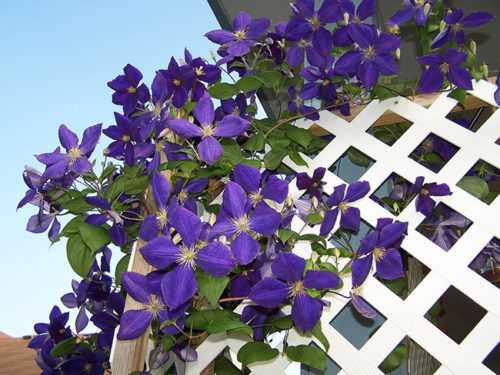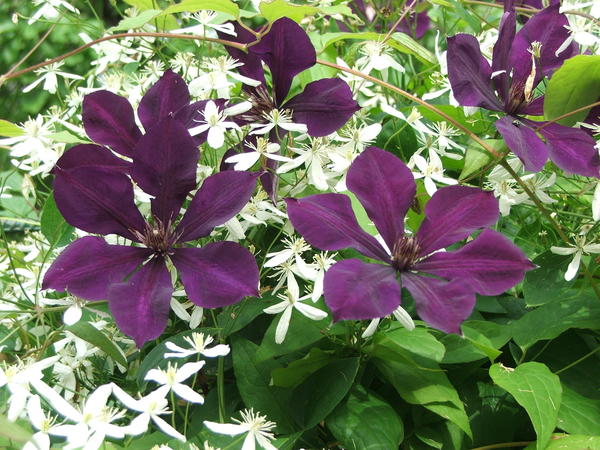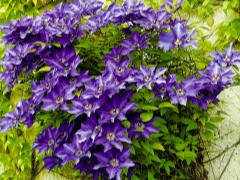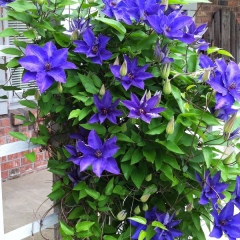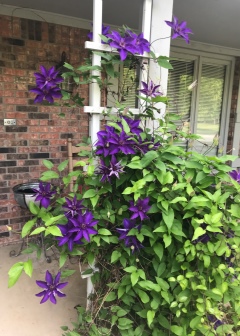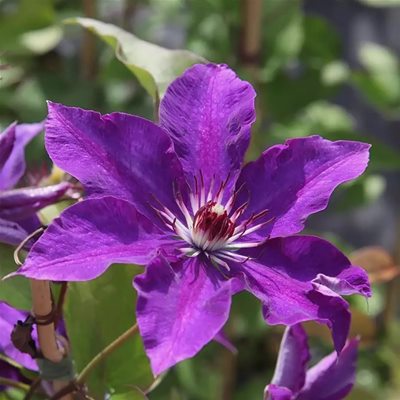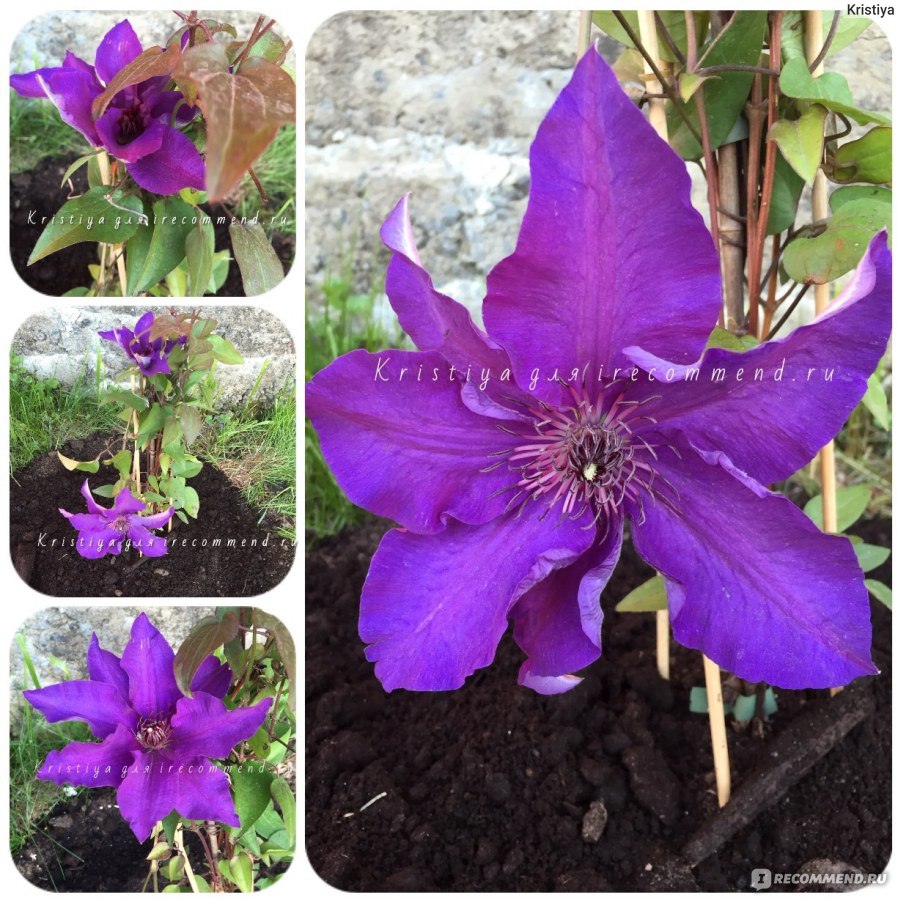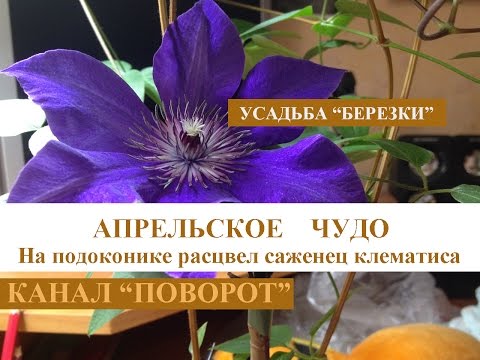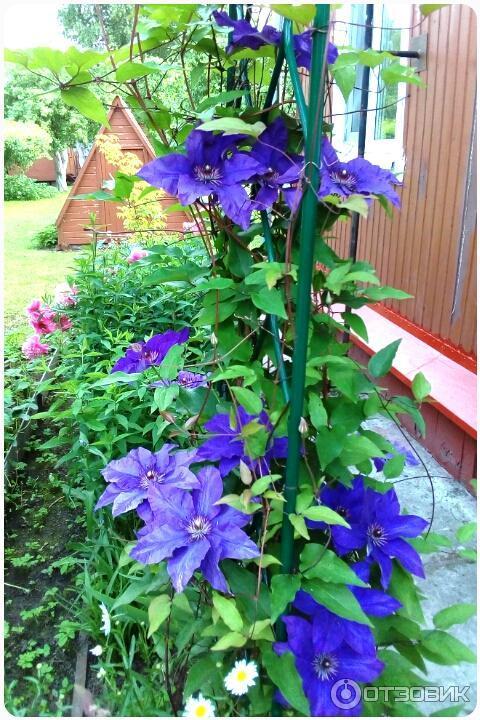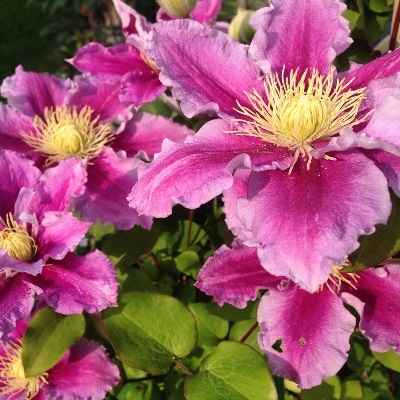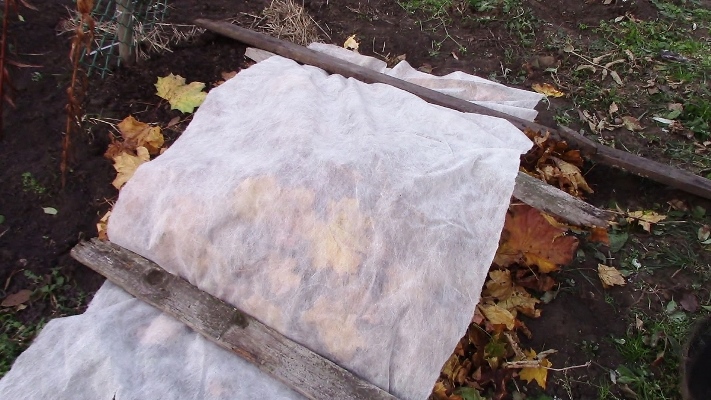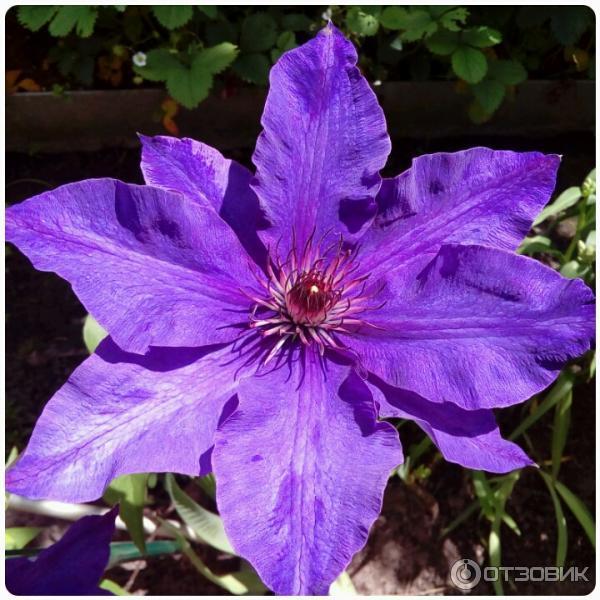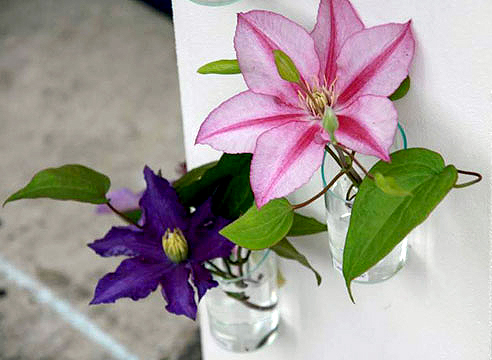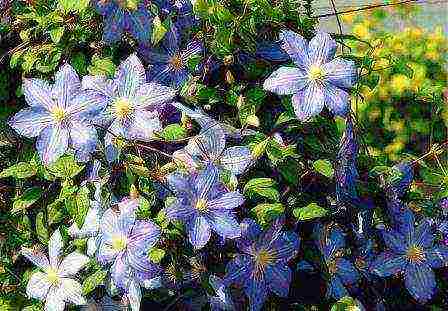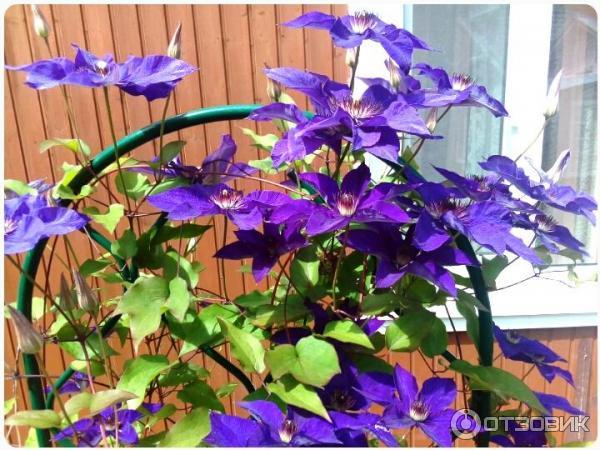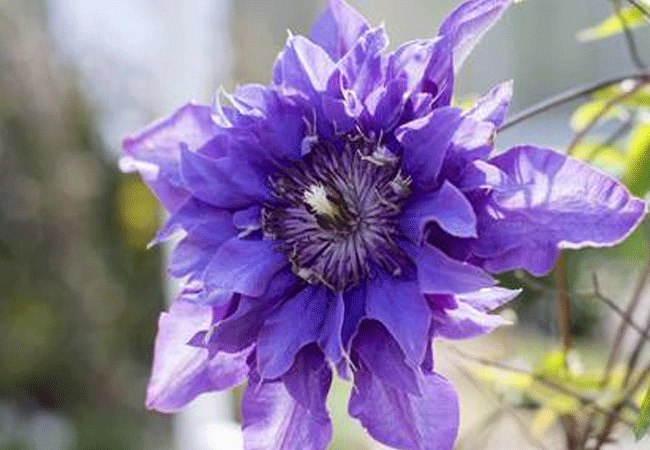Disease and pest control
The main cause of diseases and the appearance of pests is improper and untimely care of plants. Also, climatic conditions have a negative impact on clematis.
Wilt
This is a fungal infection, the main enemy for clematis President. Arises from an excess of moisture in the soil and air. The plant quickly fades, turns black and dies. In order to avoid damage to flowers by verticillium wilting, it is recommended to spray the bushes in the spring with special preparations based on fungicides.
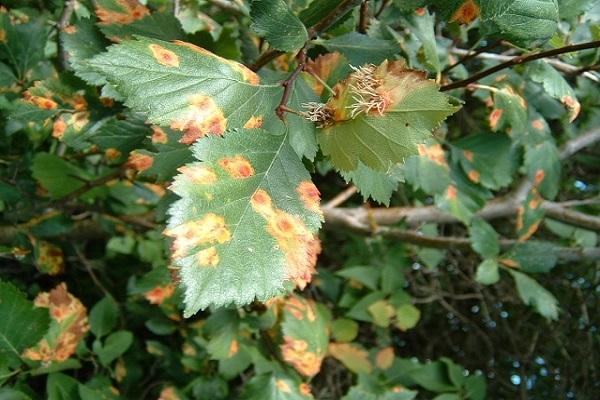
Gray rot
Gray mold spreads in a humid, cool environment. Gray, fluffy spots appear on the leaves of the creeper. The plant withers and dries up quickly. The fungus spreads quickly by air, so at the first symptoms, the bushes are treated with fungicides.
Powdery mildew
With prolonged heat and heat, the plants are affected by powdery mildew. To prevent the disease, folk recipes or preparations based on the same fungicides are used.
Rust
If yellow swellings with small particles appear on the clematis, it means that the plant is threatened with rust infection. The disease quickly destroys the leaf cover and poses a threat to the growth and development of shoots.
In order to combat fungal disease, copper-based preparations are used.
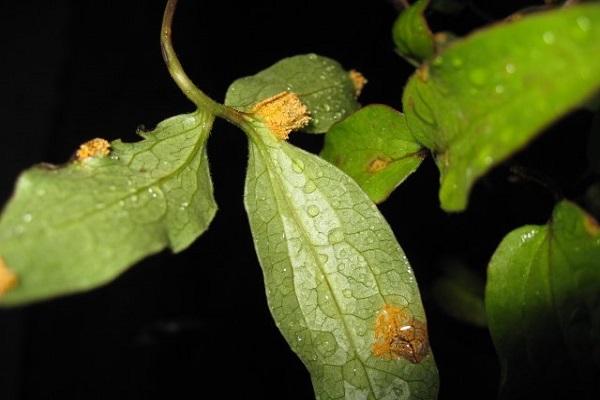
Nematodes
Nematodes parasitize the entire plant, from the rhizome to the leaf cover. Unfortunately, effective drugs to combat this pest have not yet been invented. Therefore, as a preventive measure, the roots of suspicious plants are treated with very hot water (+50 degrees), and calendula or dill are planted nearby. Nematodes do not tolerate these crops and disappear.
Important! At the place where the plants infected with the nematode grew, the soil is disinfected. For 3-5 years, it is forbidden to plant flowering vines on this site.
Rodents
In winter, rodents can damage the plant. To prevent the death of flowers, poisoned traps and baits are laid out next to them.
Description and varieties of clematis of the Knyazhik variety, planting and careRead
Aphid
To prevent the appearance of aphids, every spring I treat the plants with preparations based on fungicides. When the vines are infected with this pest, the bushes are sprayed with special solutions with the addition of insecticides.
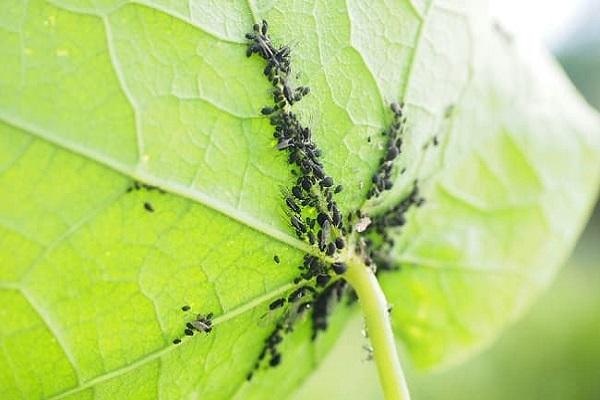
Overview of species and varieties
There are a large number of princes, and first you need to familiarize yourself with the most common types.
Views
It is worth considering the popular species that have given birth to many bred varieties.
- Alpine. These plants are native to European countries. Mostly it grows in mountainous areas. Vines can grow up to 3.5 meters. The flowers are quite bright, purple in color. The flower itself has an elongated shape, reaching up to 8 centimeters in size. Flowering can occur 2 times a year. The first time in early June, and the second in early September. It is worth noting that the second bloom is no longer so abundant. In order to rejuvenate the bush, experts recommend using periodic pruning.
- Okhotsk. It belongs to the most frost-resistant species. In its natural environment, it can be seen in the Primorsky Territory. The height does not differ from the previous species, but the shade of flowers, as a rule, is blue. In addition, they are more lush and full-bodied. Flowering begins in early June.
- Siberian. This type of princes is most often found in Siberia. It can grow both on the sunny side and in the shade. The flowering of the Siberian prince begins in the first weeks of July. The green carpet is decorated with single inflorescences, with a white or yellow color, the length of which is at least 5 centimeters.They have a very pleasant smell, which attracts a large number of bees and insects.
- Large-sized. Like the previous type of flowers, the plant grows in Siberia. They differ from other plants in their unusual structure. The outer sepals are larger than those inside. This makes them look more voluminous. Flowering begins in mid-summer. For the winter period, all vines must be removed from the supports and covered with spruce branches.
- Korean. For the first time, flowers were bred in Korea. They are long creeping vines with red-yellow buds. In rare cases, the color may be purple. However, such specimens are rarely grown in gardens.
Varieties
Next, you need to consider the most popular varieties that are grown in gardens, and in parks, and in personal plots. The most common are "Albina captivity", "Octopus" and many others.
- Cecile. Refers to frost-hardy and large-flowered types of princes. Flowering begins in early summer. The buds are blue-lilac in color.
- "Pink Flamingo". Liana grows up to two meters. There are pink flowers on it, the length of which reaches 9 centimeters. It blooms twice. The first bloom begins in late April or early May, the second in late summer.
- Ballet Skirt. This variety is distinguished by very delicate flowers with a pink tint. Most often used to create arches.
- "Midewell Hall". The vines of this plant grow up to three meters in length. On them are flowers of a rich purple hue, the length of which is no more than 5 centimeters. In their natural environment, they grow along rocky shores.
- Francis Rivies. It is a liana up to two meters, with blue flowers, the length of which reaches 9 centimeters. Flowering begins in early May.
- Stolvik Gold. This type of prince is especially beautiful and unusual. It is impossible to take your eyes off its blue buds with very lush centers. The flower can grow up to 6 centimeters in diameter. In addition, golden leaves grow on vines. Flowering can occur twice a year. For the first time - in the spring, and the second time - at the end of summer.
- "Purple Dream". This variety was bred by the Polish breeder Marchiński. Its vines grow up to three meters. On them you can see beautiful double flowers, the diameter of which reaches 11 centimeters. Their colors are most often purple-cream. Such a plant is resistant to frost.
- Lemon Dream. Another variety of the Polish breeder, which amazes with its magnificent appearance. Terry flowers with a lemon shade are quite large, up to 12 centimeters in diameter. When the flowers are just starting to bloom, they have a greenish tint, and during full blooming they become almost white. The flowering of this plant occurs 2 times for the entire time. The first time is in early May, and the second is in the middle of summer. Like the previous type of princes, this variety is not afraid of frost.
- "White Swan". This plant got its name due to the fact that it has white buds. Flowering most often occurs from the beginning of May and lasts until the end of June. In some cases, flowering can last an entire summer.
8photos
Description of clematis Mazovshe
Clematis Mazowsze is a fairly new variety, bred in Poland by the famous breeder Stefan Marczynski in 2006 and named after one of the regions in central Poland - Mazovia. In the same year, this variety received a silver medal at an exhibition in Warsaw called "Green is life". The award is well-deserved, because, judging by the photos, descriptions and reviews on the flower lovers forums, Clematis Mazovshe is a welcome guest on any personal plot.
One of the parents of Mazovsha is the William Kennett variety.
Plants of this clematis have good vigor and their shoots can grow up to 3.5 m in height. The Mazovshe variety belongs to large-flowered clematis for a reason.Flowers with velvet petals of a deep rich burgundy hue can reach 15-20 cm in diameter. 6 wide petals are folded very elegantly and at the beginning of flowering form a capacious bowl with deep cutouts. In length, the petals reach 6-6.5 cm, in width - 4.5 cm. At the ends, they are effectively narrowed. In the center of the flower, gently yellow pistils and creamy pinkish with coffee-colored dust particles form, as it were, a fluffy spherical pompon. With age, the shade of the upper petals of Mazovshe clematis may fade slightly and become pale burgundy, and the flowers themselves become flatter, as can be clearly seen in the photo.
Below, on the petals of flowers, a wide white stripe is visible, turning into a pale pink color along the edges.
Despite the fact that the flowers sit on long pedicels, they do not lean down, but all, as one, are directed upwards. The flowering is plentiful; under good conditions, sometimes you can not see green leaves at all behind the flowers. But do not expect it in the first years after planting. Clematis must first root well and develop a sufficient number of shoots, which is aided by strong annual pruning.
Plants of the Mazovshe variety bloom quite late, in the last days of June. But they are able to delight with their flowering until mid-September.
In addition, Clematis Mazovshe refers to a rather unpretentious plant. It can withstand a wide variety of light growth conditions, except perhaps deep shade and the north side of the site.
It is also a fairly frost-resistant variety, it can be safely planted in climatic zones from 4 to 9. The advantages of this clematis include its resistance to various diseases.
Types of clematis - varieties and photos
There are many varieties of clematis that differ in origin, color range, flowering time and many other differences. Thanks to this, he is so fond of flower growers. All species can be divided into 3 main flowering groups:
- Blooming last year's shoots;
- Flowering, both on last year's shoots and on the shoots of this year;
- Blossoming only on new shoots.
The first group includes the following types of clematis:
Alpine clematis
This species is considered an artisanal type liana, which reaches three meters in length. The leaf is complex, triple, toothed and large. The flowers are wide, lowered bells reaching up to 5 cm in length. The flower consists of four long and shiny sepals. Anthers come in several colors: pink, white, and cream.
This species is widespread and grows well in the mountainous regions of the south and center of Europe. Loves shade and moisture, therefore requires good watering.
Breeders have bred the following varieties of this species:
- Artagena Franchi. The variety is characterized by increased frost resistance and reaches up to 2.5 meters in height. Flowers have the appearance of blue bells and white anthers;
- Albina Plena. This variety has white double flowers that bloom in early spring. The height of the vine reaches 3 meters.
- Pamela Jackman. It blooms twice a year: the first bloom starts from April to June, and blooms again with lonely flowers in August. The flower is painted in purple shades and reaches a length of up to 7 cm.
Flowering clematis
It grows in the form of a liana, which can reach a height of three meters. Basically, the varieties have large single flowers of a light color. It does not withstand the shade and therefore it is advisable to plant it in lightened places. Also, this flower is very fond of large watering.
Among the famous varieties there are:
- Vyvyan Pennell. This clematis grows up to 4 meters in size. It blooms in large flowers with a purple-lilac color that reach a diameter of 15 cm;
- Baby. A small liana that grows no more than a meter. Large cross-shaped flowers of blue-violet hue;
- Joan of Arc. This clematis is hardy and thermophilic. Also, he is not whimsical to disease. The flowers are small, snow-white, double.
The second group includes the following types:
Clematis woolly
The history of this species begins at the end of the 19th century, when it was first discovered in England. In nature, it grows along streams in the shade of dense bushes. It grows in the form of vines over 2 meters long. The thin stem has a hexagonal shape, and the leaves are pointed and leathery. Flowers are solitary, reaching a diameter of up to 20 cm, white or purple. On old sprouts, the color begins in May, and the young ones are covered with flowers at the end of summer.
Among the most popular varieties are:
- Madame le cultre. Liana, reaching a height of 3 meters. The leaves are compound, triple. The flowers are white with an anther with a light shade. Color begins in summer and has poor frost resistance;
- Hybrida Sieboldii. It grows 3 meters long and has rather large flowers with a light lilac shade. Anthers are dark red. The variety pleases with color from July to September.
- Lawsoniana. A bushy vine that reaches a height of 3 meters. Leaves are complex, oval. The flowers are quite large with a bright red anther. The flowers themselves have a light purple hue. It begins to bloom in May.
Sprawling clematis
The plant looks like a bushy liana that grows up to 3.5 meters in length. Flowers are single, large, up to 15 cm in diameter. This look will delight the eye in many shades from white to bright blue. It begins to bloom from the end of spring. It freezes strongly during frost.
Famous varieties:
- Joan Pikton. A plant with a large number of lilac-lilac flowers, the diameter of which can reach enormous sizes up to 25 cm with wavy edges.
- Multi Blue. Leanoid plant, reaching a length of 2.5 - 3m. Large flowers have a purple-blue hue. Pleasing to the eye throughout the summer.
The third group includes the following types:
Clematis Jacqueman
This species is the product of a cross between Vercitella, Henderson and woolly clematis. It is a rather large bushy vine that can grow up to 6 meters in height. The stem is branched, brown-gray. Leaves are oval with a pointed end. Flowers are lonely or umbrella-shaped and have many shades. The size can reach up to 20 cm in diameter. To get good flowering, last year's shoots are pruned to the ground in late autumn.
The most common variety:
Bella. A small climbing plant up to 2 m high. The flowers have a diameter of up to 15 cm. The variety is very winter-hardy and resistant to fungus. Flowering occurs from July to late autumn.
Clematis Jacqueman Bella
Review of the best varieties
When summing up, it is time to consider the most beautiful clematis of the third pruning group, included in the popularity rating:
Variety Paul Ferges adequately represents white clematis of 3 pruning groups with strong growing shoots. During the season, the lashes can stretch up to 7 m in length. Shoots have good tenacity to any support. The flowering period lasts from July to early October.
Gardeners who prefer terry clematis of the third pruning group will like the Purpurea Plena Elegance variety. Scourges grow up to 2.5 m in length, but can stretch up to 3.5 m. A double flower reaches 9 cm in diameter. The petals are red with a purple tint. A feature of the variety is abundant and long flowering from early July to late September.
The varieties of pink clematis of 3 groups have a gentle charm, of which Comtesse de Boucher stands out. The lashes are stretched from 3 to 4 m long. The flowers are large, about 15 cm in diameter. The petals are pink, there is a slight waviness along the edge. The stamens are yellow. The variety has a long flowering beginning in July.
Another representative of snow-white clematis is the Roco-Kolla variety. The culture was developed in Estonia. Liana is independently capable of clinging to any kind of support and can even braid a coniferous tree. However, the length of the lashes is small, a maximum of 2 m. Snow-white flowers with cream veins on the petals appear in August, delighting with their beauty until October
Considering clematis of the third pruning group, varieties, photos, lovers of new products can pay attention to Morning Sky. Liana bred by Polish breeders
The bush throws out lilac flowers. Pink streaks are clearly visible on the petals. Bloom lasts from June to August.
Considering clematis of 3 groups of the best varieties, it is worth stopping your gaze on the beautiful Madame Julia Correvon. The bush is densely covered with red wine-colored flowers from June. Liana blooms in September. The plant tolerates cold winters well, adapts to any type of soil, does not require complex maintenance. The lashes are vigorous, capable of stretching up to 4 m. Designers and gardeners use the variety for arranging hedges. A mesh is often used as a support.
Fans of decorating gazebos and other recreational areas with hedges will love the Grunwald variety. The flowers grow large, reaching a diameter of 12 cm. The petals in the sun play with a purple hue. Scourges grow up to 3.5 m long. Flowering begins in June and lasts until September.
The Arabella variety pleases with purple flowers. The creamy corolla gives the inflorescence elegance. The variety is often planted in the garden to decorate recreational areas. Flowering begins early - in June. Liana blooms in October. Scourges grow up to 2 m long. The bush is so densely covered with purple inflorescences that sometimes foliage is not visible behind them. The variety has good winter hardiness. Due to its short stature, Arabella can be grown on the balcony.
Considering clematis pink 3 groups, varieties, photos, special attention should be paid to Alyonushka. A low-growing liana throws out beautiful bells. The bush grows only 1.5–2 m in height. Flowering begins in June and ends in September. Liana has good frost resistance. The plant easily takes root in the middle lane. The disadvantage of this variety is the impossibility of self-weaving shoots. The stems must be constantly tied to a support.
Danuta variety will appeal to lovers of large flowers. Inflorescence petals are slightly wrinkled, wavy along the edge. The color is pink with a lilac tint. Early flowering begins in June and ends quickly in July. Scourges grow up to 3.5 m long, but on average they stretch out to about 2.5 m. Shoots are able to easily cling to supports on their own. The plant tolerates frosty winters well.
There are many varieties and types of clematis of the 3 pruning group, which are almost impossible to consider at once.
Breeders are constantly developing new flowers adapted to different climatic conditions. True lovers of clematis should constantly monitor new products, and when they appear, try to grow on their site.
Reproduction
Methods:
- dividing the bush;
- pinning shoots in spring;
- reproduction by autumn layers.
 Dividing the bush
Dividing the bush
... The method is acceptable for adult plants not older than 6-7 years. Older bushes have a developed root system, which can break off when separated. To separate the bush, it is dug up, freed from the ground, cut with a sharp or pruning shears so that each plant has buds on the horse's neck.
Pinning last year's shoots
... In pots with loose fertile soil. The shoot is pinned at the site of the knot formation. The pots are buried in the ground in advance.
As young shoots grow, the soil is covered with a tubercle. By the fall, strong seedlings grow from the shoots pinned in the spring.
Reproduction by autumn layers
... Carried out around October. All flowers and leaves are cut from the shoots to a well-developed bud, which will take root. Long shoots can be rolled up and placed in grooves prepared in the soil. The groove is covered with a layer of peat that perfectly retains moisture and allows air to pass through. Cover the layers well with dry leaves or hay. Water the planting site well in the spring. In the fall, young shoots can be planted in a new location.
With Nelly Moser climatis on the site, you will get many large, beautiful flowers with long flowering twice a year. The flexible plant will decorate any corner of the garden. Clematis looks against the background of coniferous trees, blooming lilacs and viburnum.
Clematis

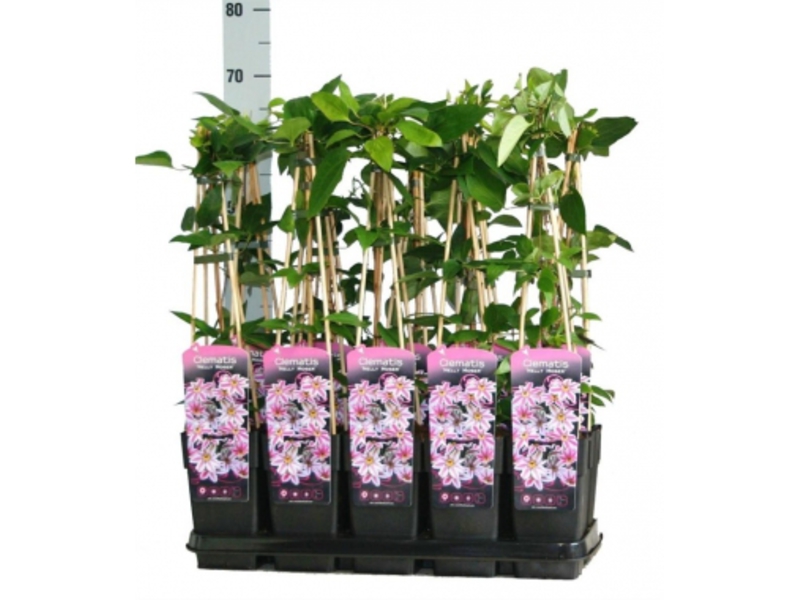
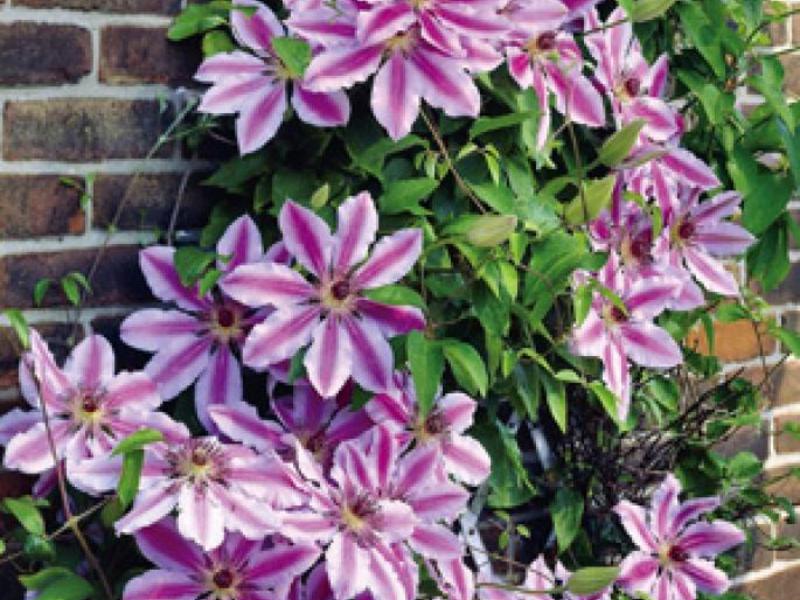
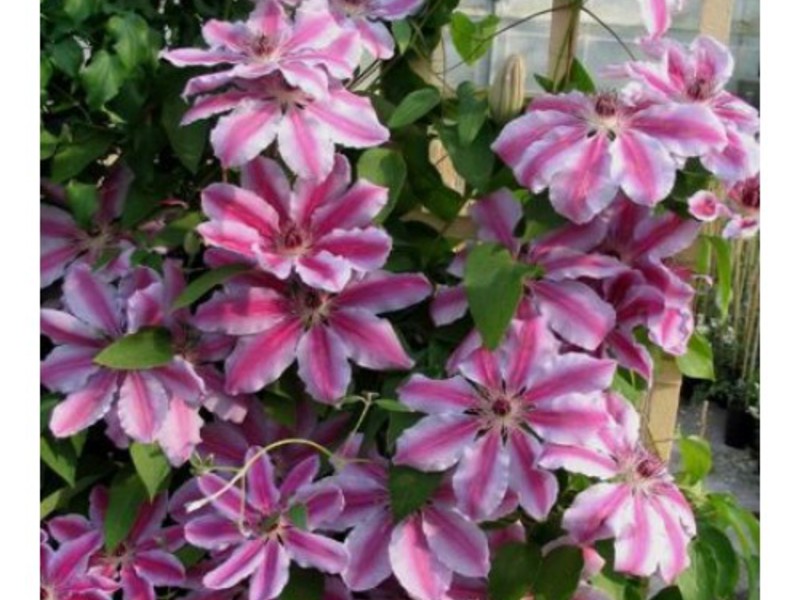

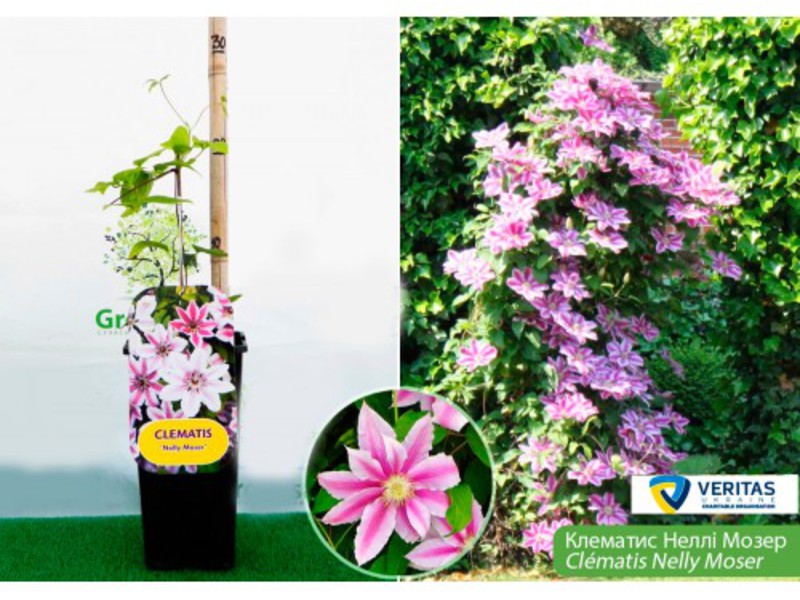

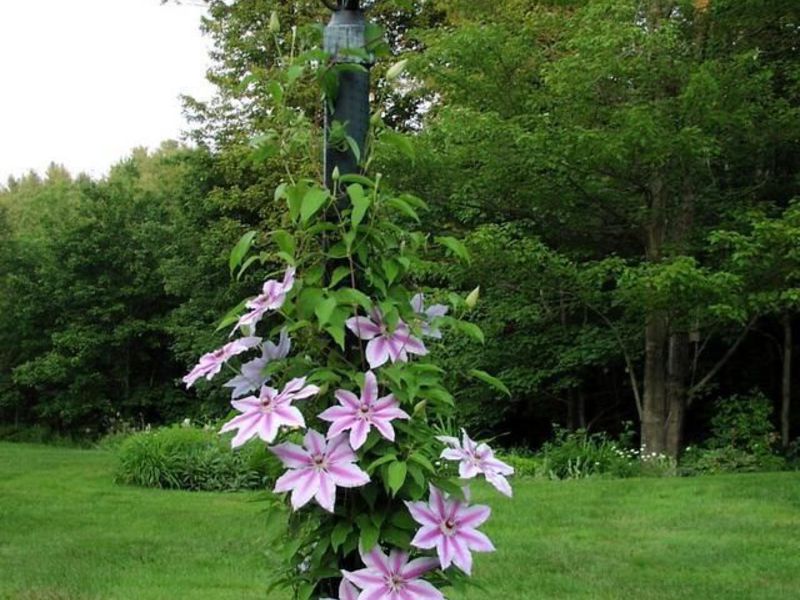

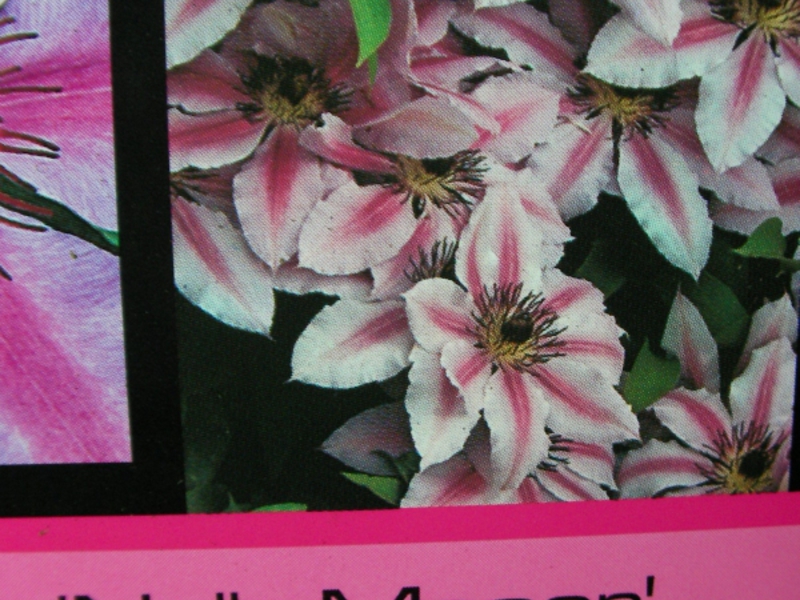
Clematis is an incredibly beautiful plant that is actively used by summer residents and gardeners for vertical gardening of gazebos, shelter and decoration of the walls of the house and outbuildings. Translated from Greek "clematis" is translated as "liana" or "vine". The whole beauty of a flower is that, clinging to the support, it weaves up through it, beautifully braiding it. A bright waterfall of large, spectacular flowers falls from a height, causing everyone to delight and admiration.
Clematis from the buttercup family. In nature, there are up to 300 plant species that can be found in all parts of the world. In our country, a huge number of its varieties and species are grown. Gardeners especially liked this clematis variety like nelly Moser belonging to the Patens group. Clematis nelly moser is a shrub vine that reaches a height of over two meters. The main advantage of the variety is the large star-shaped flowers of a pale pink-lilac color.
Clematis President: caring for a hybrid variety
When the shoots grow up, they are carefully tied to the support and directed towards the lower one. Some shoots are given a horizontal direction so that flowering occurs around the entire perimeter of the garden trellis. This lush flowering plant needs systematic maintenance in order for the plant to develop well. This clematis requires a watering procedure every week, and in extreme heat and drought, the number of waterings is increased to three times a week. In the first year of the plant's life, up to 20 liters of liquid is poured under the bush at a time. And for an adult shrub, respectively, twice as much, up to 40 liters of water. After the watering procedure, the soil is loosened. In addition to all this, mulching is carried out in hot weather; dry grass and weeds are used as mulch.
In spring, the plant is treated with fungicides against diseases and pests. If spider mites and aphids are found in the summer season, the plant is treated with acaricides and insecticides.
It should be said that in the first year of clematis's life, the buds are cut off in order to strengthen the roots of this shrub.
Top dressing.
If there is such a possibility, then organic fertilizers are applied to this variety of clematis. Before the winter season, humus is sprinkled on the landing hole, and in the summer, liquid mixtures of mullein or bird droppings are poured three times. Also, three times clematis is fed with mineral fertilizers. They do it like this:
- At the beginning of the active development of the plant, urea dissolves in 10 liters of water, about 35 grams. One shrub takes five liters of the mixture.
- During the flowering period, top dressing is made as follows: nitrophoska 35 grams and potassium humate 20 grams are dissolved in 10 liters of water. One bush takes one bucket of such a solution.
- After the flowering period, the plant is fed with such a solution: 40 grams of superphosphate and potassium sulfate are dissolved in 10 liters of liquid. One bush takes half a bucket of solution. Moreover, superphosphate the day before is soaked in one liter of hot water, and then diluted to the required rate.
Specialty stores have a huge number of different flower dressings that are also suitable for this plant.
Clematis President: Pruning Group and Circumcision Rules.
To regulate the flowering process of hybrid clematis, the President, his shoots are cut twice. After the first period of flowering at the bush, absolutely all last year's shoots are cut off at the very base. In September, those shoots that have grown since the spring are cut off. And in this case, there are two ways.When cutting off the entire shoot entirely to the very root, in the next spring period, the early flowering period can not be expected. To start flowering in June, only the generative part is cut off on new shoots, where the flowers grew.
Preparing for the winter period.
The endurance of the President's hybrid clematis is at a high level, but growing in central Russia, the plant still needs shelter for the winter. In the autumn, mulching is carried out with sawdust, peat or fallen leaves
The plant is very carefully removed from the support and folded very carefully and carefully. With the arrival of frost, coniferous branches or dried tops of flower and garden crops are spread
They begin to open gradually, with the onset of warm days.

